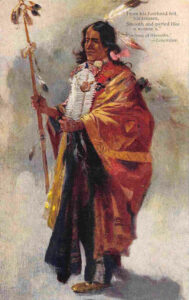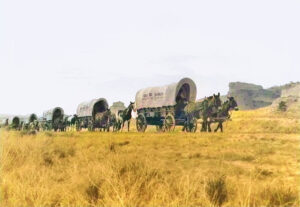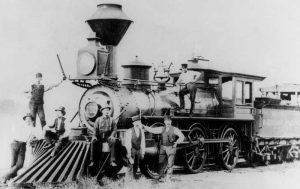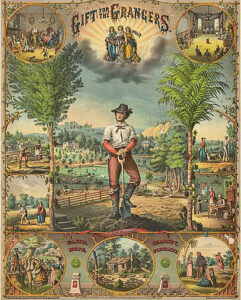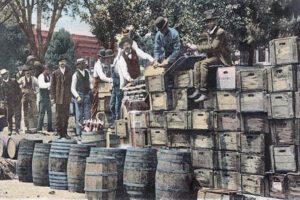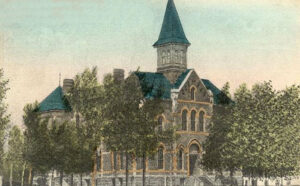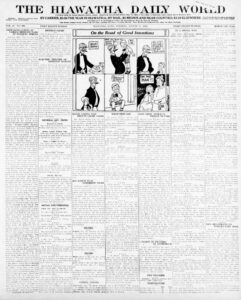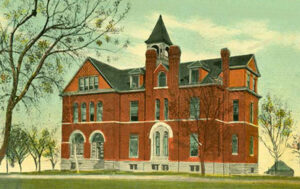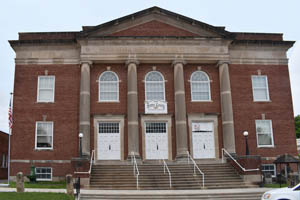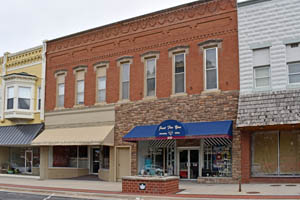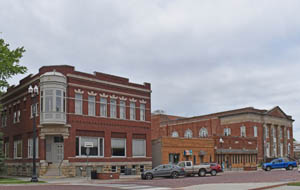Hiawatha, Kansas, is the largest city and county seat of Brown County. As of the 2020 census, the city’s population was 3,280, and it had a total area of 2.59 square miles, all of which is land.
In 1857, E.N. Morrill, a native of Maine, organized a group known as the Maine Colony to settle in Kansas. Morrill represented this section in Congress 26 years after arriving in Hiawatha. And 12 years after that, he became governor of Kansas.
Founded in 1857, Hiawatha is one of the oldest towns in the state. John M. Coe, John P. Wheller, and Thomas J. Drummond were instrumental in organizing the city, and the site was staked out on February 17, 1857. B.L. Rider reportedly named Hiawatha, taking the young Indian’s name from Henry Wadsworth Longfellow’s poem, The Song of Hiawatha.
The main street was designated Oregon Street after the Oregon Trail. The first building was erected for hotel purposes and occupied by Partch & Barnum. It stood on the northwest corner of Sixth and Oregon Streets. A. Sellig later managed it. The second building was constructed by Mr. Partch and situated on the east side of Sixth Street, directly opposite the courthouse. It was occupied as a general store by H.R. Dutton and B.L. Rider.
The First Methodist Episcopal Church was not the only Methodist Church in the city and county, but it was the first church of any denomination. In 1857, Hiawatha was part of the White Cloud and Sabetha Mission, which Reverend W.E. Butt, the presiding elder, led.
Hiawatha became the Brown County Seat in 1858. A 30-foot square courthouse was built for $2,000. It had four rooms and a hall on the lower level. The upper level was a courtroom and jury room. On April 19, 1858, county commissioners met at the new courthouse for the first time.
A post office was established on July 13, 1858, with H. R. Dutton as the first postmaster.
The First Baptist Church of Hiawatha was organized on August 18, 1860, by Reverend H.S. Tibbits. At that time, the society numbered 15 but grew in the years that followed. A church building was erected in 1871 at Eighth Street, near Utah, for $3,100.
The first newspaper published in this county was the Brown County Union, which first appeared in the spring of 1861. In the early days of the county, during the excitement of the Civil War, publishing the newspaper was an unprofitable and laborious task. Its owner, Dr. P.G. Parker, may have felt a sense of relief when the building caught fire that winter. No attempt was made to revive it.
The first issue of the Union Sentinel appeared on August 20, 1864, under the editorship of Mr. H.P. Stebbins. On August 16, 1866, H.P. Stebbins sold the newspaper to Ira J. Lacock and J.W. Oberholtzer, who made several improvements and finally sold it on November 7, 1867, to David Downer. In his hands, the publication continued for nearly three years before it ceased publication.
In November 1866, the Union Sentinel said:”
We have in Hiawatha two dry goods stores, one drug store, one grocery and saloon, one saddle and harness shop, one shoe-maker shop, one wagon-maker shop, two blacksmith shops, one cabinet-maker shop, one flouring mill, one first-class hotel, one meat market, one church, a courthouse, one livery stable, two doctors, four lawyers, three carpenters, one stonemason, one Masonic lodge, one printing office, one free school and all other things for a flourishing town with a population of over three hundred souls.”
The Hiawatha Mill was built in 1868 by Covode & Snively for $14,000 and stood near the tracks of the St. Joseph & Western and the Missouri Pacific Railway. The building was 75 by 35 feet and two and a half stories in height. The machinery of the mill consisted of four runs of buhrstones, three of which were used for wheat and one for corn. Power was furnished by a boiler of 80 horsepower and an engine of 40 horsepower. The mill had a capacity estimated at a daily reduction of 140 bushels of wheat and 80 bushels of corn. It furnished employment to four hands running during the day and to six when employed at night. The property was purchased in 1882 by Mr. P.D. Tobie.
The First Congregational Church of Hiawatha was organized on June 5, 1869, with a membership of 15, under the charge of Reverend G.A. Hoyt. A church building was begun in 1873 and dedicated in January of the following year for $4,000.
The Hiawatha Library Association was organized on February 11, 1870. Citizens made donations to the town, and several books, including some valuable editions of standard works, were gathered together. A room in the stone building was secured and opened to the public, and later, a room in the old courthouse was also made available. The library, however, did not flourish as it should have, and the Association died out around 1873; the books were then transferred to the public school building.
The earliest record of the public schools of this place bears date March 25, 1870, and records the election of E. Bierer as Director; B.F. McCoy, District Clerk; and George Amann, District Treasurer. In 1871, two lots were purchased on Miami Street in the northeast part of the town as a site for a schoolhouse.
The First Presbyterian Church of Hiawatha was organized on April 10, 1870, by F. E. Sheldon, who, while stationed at Troy, Doniphan County, preached once in six weeks at Hiawatha for more than two years. A 30×40-foot church building was erected in 1873 for $2,938.
The Hiawatha Despatch was started on April 30, 1870, by A. N. Ruley, and from that date to April 4, 1878, the publication continued under his control. For the first two months of its existence, the Despatch was a seven-column folio but was then enlarged to an eight-column sheet and, as such, ran to the end of its race. Upon the retirement of Mr. Ruley, the paper passed into the hands of W. T. Stewart, who conducted it until March 1, 1882.
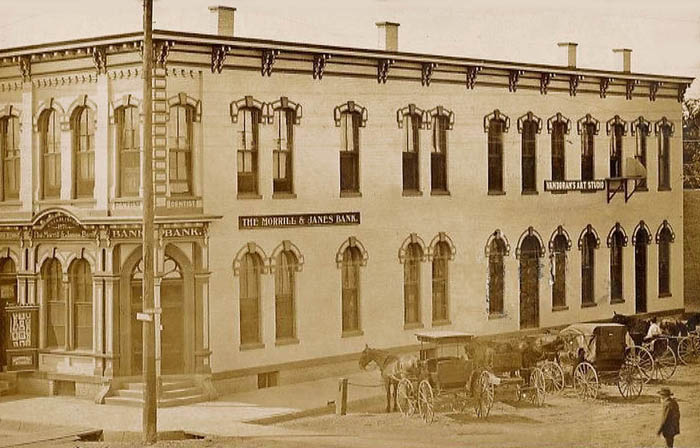
Morrill & Janes’ Bank in Hiawatha, Kansas.
Morrill & Janes’ Bank was formed on January 1, 1871, under the title of Barnett, Morrill & Co., and transacted business in a room over the drug store on Oregon near Sixth Street. In 1872, a new bank building was erected, including the lots, for $8,500. Its size was 25 by 50 feet. It had two stories, but only the first was used for banking purposes. In 1882, an L-shaped building was constructed around the bank, resulting in a structure measuring 50 by 100 feet. This bank was a private one and made no statement of capital or assets, but it was universally considered one of the most reliable in the State.
In April 1871, a full complement of city officers was elected as follows: Mayor, J. Shilling; clerk, H. J. Aten; treasurer, James A. Pope; marshal, J. B. Butterfield; assessor, F.J. Heller; police judge, J.W. Oberholtzer; attorney, C.W. Johnson; councilmen, J.W. Pottenger, B.F. Killey, G. Amann, H.M. Robinson, and H.C. Wey.
On November 30, 1871, a destructive fire erupted at the drug store of Mitchell & Zehrung on the east side of the Public Square around 2:00 a.m. The flames spread quickly, making it impossible to save the building. Efforts then shifted to rescuing the belongings of Mr. Mitchell, the senior partner, who lived above the store. However, firefighters were hampered by dense smoke and explosions from the burning drugs. Realizing they couldn’t save the drug store, townspeople focused on nearby wooden structures, including the boot and shoe store of J.B. Butterfield, the shoe shop of F. Zimmerman, and the hardware store of A.M. Blakesly. With limited resources, these buildings could not be saved, and their contents were hastily removed. The hardware store held a heavy inventory that could not be evacuated. To protect the adjacent residence of Mr. I. Boker, firefighters decided to demolish the nearby jewelry store of Mr. T.B. Dickason. After clearing the stock, they quickly dismantled the store, stopping the fire’s spread. The total loss from this incident was around $12,000.
On March 28, 1872, the first Grange in Kansas was organized at Hiawatha by Joshua Ball, and officers were elected. A petition for a charter was signed by 27 males and 17 females and forwarded to the National Grange in Washington, D.C.
The African Methodist Church of Hiawatha was organized by Reverend Robert Kay in 1872. The society had a church building in the southeast part of the town, which was 20 feet by 30 feet, erected for $400.
The First German Reformed Church of Hiawatha was also organized the same year by Reverend John Beck, Pastor. Services were held in the county courthouse until March 1878, when the old school building in the northeast was purchased and fitted up for church purposes. By the early 1880s, the society had a membership of 60.
The Speer Elevator was built in 1873 for $10,000. The two-story main building was 26 by 40 feet. The ground space covered by the building and additions was 26 by 90 feet. The elevator had a capacity of 15,000 bushels. An engine of 15 horsepower furnished power. The shipments in 1881-82 were more than 250,000 bushels.
The same year, a schoolhouse was built for $6,000. This two-story structure, built of native stone, measured 50 by 32 feet. On April 4, 1873, the appointment of three teachers was recorded. These were L.S. Herbert, Principal, Miss Albee, and Miss Welcome, Assistants. The stone schoolhouse was considered a spacious building, well-suited to the school’s needs for several years to come. However, only a year later, it was found necessary to obtain better accommodations due to the city’s growth. At a meeting held on April 10, 1874, it was decided to build a new permanent schoolhouse, not to exceed the cost of $35,000. One-third of this sum was to be expended in the first year, and the remainder during successive years.
The Hiawatha Fire Department was organized in 1874, with a membership of 30, with H.M. Waller as Chief. A truck with hooks and ladders was purchased, and the apparatus was placed in a building west of the new National Bank Block. The department met on the first Monday of each month.
The first issue of the Brown County Advocate was circulated on June 25, 1874, by Davis & Watson, with E.A. Davis as editor. The editorial newspaper was a nine-column folio of large size. Mr. Davis retired from the editorial chair after a few issues of the paper and, with Mr. S.L. Roberts, formed the firm of Davis & Roberts. The newspaper continued to be published by this firm until February 1875, when Mr. Davis’ connection with the paper finally ceased, and Mr. D.L. Burger took his place. In the following October, the name of the publication was changed to the Kansas Herald.
On February 22, 1875, the board received a petition from over one-third of the district’s legal voters, requesting a special election to issue $15,000 in bonds for a new schoolhouse. The election was scheduled for March 6, where the vote was 146 in favor and 58 against the bonds, which had a ten-year term and were to be sold for no less than 95% of their par value. Following this decision, an election was held on March 20 to choose a building site. Site Four, owned by Mr. Bowers, won with 54 votes, securing a majority. Plans from Steiger, Boetner & Co. were selected, and the contract for construction was awarded to Mr. B. Amann for $13,000. The school featured seven classrooms, with a teaching staff led by principal L.D. Whittemore and six other teachers. With over 400 students enrolled, it quickly became clear that the facilities would soon be insufficient.
In 1875, the City Council denied all license applications to open saloons or drinking places. For a time, this suddenly enforced prohibition was effective.
The Hiawatha Club was established on October 7, 1875, on Oregon Street, to operate a beer club and saloon in violation of the law. Fred W. Rohl and Henry Stauff ran it. To evade liquor laws, members exchanged tickets for drinks. Eight days after it opened, Mayor H.J. Aten ordered City Marshal Woodmansee to close the club, but it quickly reopened. Rohl and Stauff forcibly ejected the marshal, prompting him to call for backup. They broke down the door, removed the occupants, and locked the building. Rohl then filed a riot warrant against the marshal and his posse, but they were acquitted, and the costs were assigned to Rohl. Despite their continued defiance, Rohl and Stauff were arrested on November 18 for selling liquor and fined $50 each. After appealing, they were arrested again on November 27 for maintaining a public nuisance, resulting in another conviction in court.
The Hiawatha Club faced significant backlash from the community, prompting many patrons to withdraw their support. Nevertheless, Rohl and Stauff continued selling beer and whiskey.
On December 15, Mayor Aten issued a writ to abate the nuisance, but the marshal’s attempts to enforce it were thwarted by Rohl and Stauff, who threatened him with revolvers. On December 25, the marshal summoned 20 men to form a posse, armed with revolvers, shotguns, and sabers. They forcibly entered the saloon, ejected Stauff, and Rohl retreated. The posse destroyed the liquor, seized the club’s documents, and barricaded the doors with furniture. Although supporters of the club threatened retaliation, no attempts were made to reclaim the building. The marshal maintained control until a district court injunction prevented Rohl and Stauff from interfering with the property. This ended the Hiawatha Beer Club, but Rohl and Stauff faced further issues. Stauff sued Marshal Woodmansee for $500 in damages, while both men sued several posse members for $5,000 each. Stauff also sought warrants against others for assault, but those charges were dismissed.
In May 1876, Rohl and Stauff surrendered to the sheriff due to unpaid fines and were jailed. Their friends broke them out, but they were soon recaptured. Eventually, Reverends Shackelford and Liggett helped negotiate a settlement, resulting in the dismissal of all prosecutions and fines, though Rohl and Stauff agreed to cover the costs. However, Rohl and Stauff had already declared bankruptcy.
In the meantime, the courthouse had been deemed unsuitable, and county offices were relocated to various businesses throughout town. It would be several years before construction of the second courthouse would begin.
The Christian Church was started in the spring of 1876 by Reverend James McGuire. A verbal contract was made to use the old stone schoolhouse, where services were held until about the close of the year, when a misunderstanding arose between the school board and the church society. The place of worship was then relocated to a room used for court purposes in the Knapp Building, located north of the public square. On May 16, 1878, two lots on Kickapoo Street were purchased for $325, and a church building committee was appointed. Money for building purposes was pledged for $2,000. Work on the building began, and by August, the foundations were completed. Afterward, the progress was rapid, but the building burned down on October 19 after $2,500 had been expended, and it was nearly complete. Undaunted, the building committee met and devised means for rebuilding on October 21. Work was begun at once, and on the anniversary of the day that saw the destruction of the first building, the second structure was dedicated. The expense of this latter building was $2,000.
The United Presbyterian Church of Hiawatha was organized on October 28, 1876, with a membership of seven. This work was by Reverend Marion Morrison, a missionary of the Presbyterian Home Missionary Society. By the early 1880s, the society had 52 members, with services held in the New Hall of Thomas Block.
On October 4, 1877, the county commissioners decided “That a proposition be submitted to the people on November 6, authorizing the board to build a new courthouse, the cost not to exceed $20,000.” The people approved this measure, and the commissioners, early in 1878, contracted with E.T. Carr of Leavenworth for its erection. The second courthouse was a two-story brick structure built in 1879 for $20,000 by James A. McGonigle and designed by E.P. Carr.
On Sunday morning, October 5, 1879, watchman Huff, in making his two o’clock round, discovered a fire in the upper part of the Hiawatha House. This hotel, built nearly 22 years before, was in 1879 of a highly composite order of architecture. The older portion of this building was made of brick, but a significant frame addition had been made to it. It was on the upper floor of this part that flames were discovered. A large crowd of citizens turned out in response to the flames, but though burning slowly, the house was doomed. Attention was then given to rescuing as much of the house’s furniture and the personal property of its occupants as possible. Mr. Ellis T. Carey, who was running the hotel, was fully insured. The hotel was also insured for $2,000, which nearly offset the loss. The destruction of this hotel was a loss to the town for the time only; the erection of its namesake more than compensated for any trade divergence through a lack of hotel facilities.
Work on the Opera House Building began in the summer of 1880 by the Hiawatha Building Company on the corner of Oregon and Fifth Streets. The capital stock of this new company was $25,000. Completed the following season, the ground space occupied is 75 feet on Fifth Street and 80 feet on Oregon Street. On the ground floor were three stores, 25 feet in front and 80 feet deep. The post office occupies the corner store of this building. The second was by S.C. Hall, and the third was by the drug store of Hulse & Kinsey. The Opera House was located on the second floor and measured 80 by 50 feet, with a stage that was 20 feet wide by 15 feet deep. It was neatly fitted with folding chairs for 300 spectators, plus room for an additional 150. The scenery consisted of four sets of flats, very neatly painted. On each side of the stage were dressing rooms of convenient size. The entrance to the house was by a broad, straight stairway leading from Oregon Street. The lodge room of the Masonic Fraternity occupied the entire third floor and was constructed by the building company for $3,500.
The first courthouse was demolished in 1880.
The Hiawatha House was built in 1880-81 by the Hiawatha Hotel Company. The first-class hotel building stood opposite the public square and on the corner of Fifth and Utah Streets. It was constructed in the most substantial manner of brick, had three stories on the north and two on the south and east sides, and contained 40 rooms. It was under the management of Mr. J.Q.A. Jeffers.
The Evangelical Church was organized in April 1881 with 15 members under the leadership of Reverend Philip Fricker. At the time of its organization, the society numbered fifteen, and in the year of its life, it has nearly doubled, now having more than twenty-five members. A church was begun in the summer of 1881 and completed the same year for $2,300. Its dimensions were 32 by 52 feet, with a seating capacity of 400.
The First National Bank of Hiawatha was chartered in October 1881 and began business on November 22 in a new building on the corner of Oregon and Seventh Streets. The bank’s capital was $50,000. Its officers were M.S. Smalley, president; S.A. Fulton, cashier; D.K. Babbit, vice president. The elegant three-story building was erected in 1881 for $17,000. It was 50 by 90 feet on the ground floor and was of St. Louis brick with stone trimmings.
The Hiawatha Cornet Band was organized on January 1, 1882, with 14 members and a drum major. The band was under the leadership of W.B. Kingsley, who, in three months, brought them to a very creditable condition. The organization purchased instruments for its members, and individual members also owned others of nearly equal value. Meetings were held in the courthouse each Monday and Thursday.
The Kansas Mutual Life Association, with its home office in Hiawatha, was chartered under the laws of the State of Kansas on January 16, 1882.
The Hiawatha World was started as the successor of the Hiawatha Despatch by the World Printing Company on March 1, 1882. The company consisted of D.W. Wilder, John B. Campbell, and Cyrus B. Bowman. The newspaper was an eight-column folio with a listed circulation of 300, but was estimated to have a circulation of 1,200. It was issued on Thursdays. Later, the name was changed to the Brown County World. Years afterward, it became the Hiawatha Daily World and continues to serve the Hiawatha community.
The Morrill Public Library was opened on May 29, 1882. Major E.N. Morrill donated $2,000 on the condition that the city would provide adequate rooms for library purposes and also bear the expenses of lights and attendance. The City Council accepted this proposition, and five Trustees were then appointed to have charge of the purchase of books and the subsequent conduct of the library. After Major Morrill’s donation, Mr. Charles Janes offered $500 and a yearly donation of $100, and also presented a set of the Encyclopedia Britannica, valued at $160. A cozy room overlooking the bank of Morrill & Janes was immediately fitted up, and all the latest appliances for comfort in reading or consultation were installed in it. The first installment of books was received on May 25, and the opening followed as soon as the necessary work of cataloging and arranging could be done.
By 1885, Hiawatha had become an incorporated city, served by the Missouri Pacific and the St. Joseph & Grand Island Railroads. At that time, the community had Methodist, Christian, Congregational, Baptist, Presbyterian, Reformed, and German-formed churches, a graded school and a private academy, two banks, eight weekly newspapers, including The World, The Messenger, and The Kansas Herald, as well as other amenities of a thriving community. The assessed valuation of the area and personal property was $400,000. Grain and livestock were the principal shipments, and semi-weekly stages ran to White Cloud and Netawaka, while tri-weekly stages ran to Capioma.
The Hiawatha Academy, a Christian school that opened in 1887, was located in the same area as the old high school, close to Hawthorne House.
The First National Bank constructed the Clock Tower Building at 701 Oregon Street in 1891, following a fire that destroyed the block and its former location. Designed by Harvey Ellis, the two-story building features a red brick exterior. The two-story Romanesque building fills a corner lot, with its primary entrance in a tower on the northwest corner. The tower has bands of rusticated stone above the first and second stories and is topped by a finial tower with clock faces on the north and east sides. The building’s east side is four bays wide; each bay has a stone Richardsonian Romanesque arch in the first story, and a brick gable pediment containing an inset rectangle of terra cotta.
The building has housed many businesses over the years, but it has also spent time sitting empty and collecting dust. Several years ago, the building was acquired for a history center, and the Frances Sewell Plamann History Center was opened on the second floor, with City of Hiawatha offices on the first. The Historical Society manages the History Center and often features displays and exhibits.
Hiawatha also fell victim to several large fires that damaged downtown areas and the business district. The first recorded fire occurred on January 6, 1890, at the Hiawatha House Hotel, situated on Oregon Street near the Depot. As 40 people were staying there at the time the fire broke out, several people were injured or killed in the blaze, which was discovered about 1:00 a.m. The second fire burned Morrill and Janes Bank and much of the downtown in about three hours on September 3, 1890. It started at a livery stable around 1:00 a.m. Following these two fires, the townspeople requested a louder fire bell.
In the later years of the 1800s, Hiawatha experienced several severe weather-related incidents, including a series of tornadoes that occurred over several years, causing substantial damage outside city limits and in neighboring communities.
In 1910, Hiawatha was the second-largest town in Brown County. At that time, it was located on the Missouri Pacific and the St. Joseph & Grand Island Railroads. It was an incorporated city of the second class. It had over 100 business establishments, among which were three banks, a mill, a bottling works, a feed mill, a washing machine factory, greenhouses, an opera house, and six publications, including the Brown County World, daily and weekly: the Kansas Democrat; the Key, a monthly; the School News, monthly; Herbert’s Magazine, and the Hiawatha News. The city had waterworks, a fire department, a sewer system, electricity for lighting and power, and a handsome park with a bathing pond. A public library was maintained in the building of the Ladies’ Art League. The Hiawatha Academy was located there. The town was equipped with telegraph and express offices and had an international money order post office, along with six rural routes. Its population was 2,974.
Hiawatha began presenting a Halloween parade in 1914. Today, it is the nation’s longest-running continuous Halloween parade.
The Hiawatha Academy closed in 1915. However, the facility was used over the years for purposes related to the school district.
In 1920, the Memorial Auditorium was built as a memorial and tribute to the American soldiers who fought in the Civil War, the Spanish-American War, and World War I. It featured a large stage and seating for 1,200, hosting traveling troupes that included actors such as Mickey Rooney and Judy Garland. The building also served as a community center for various public functions.
In the mid-1900s, school consolidation began, and larger schools, such as Hiawatha High School, were built with an auditorium. This was a blow to Memorial Auditorium, as it lost its purpose of hosting school programs, recitals, and graduations. City officials at the time deemed it a burden, and the building was closed and left to deteriorate. However, in the 1970s, community members came together to save the building and repurpose it as a museum. In 1980, the Historical Society acquired the building from the City of Hiawatha to serve as its primary museum, and it was listed on the National Register of Historic Places on September 5, 1985.
Hiawatha’s Electric Park, a much-loved community area, was developed by Businessmen Charley Scott and August Sheid. Located at 11th and Iowa Streets, it had its Grand Opening on July 4, 1921. The approximately 12-acre park featured numerous amenities for families to enjoy. It featured a 40-foot by 80-foot dance pavilion, which also doubled as a skating rink, a drive-in movie theater, a Jasbo Swing, ponds featuring boating and water activities during the warmer months, and a 500,000-gallon swimming pool. It also sometimes featured live circus acts. At some point, it was torn down, and there are no remains today.
The three-story limestone Classical Revival courthouse was built at 601 Oregon Street in 1925. Designed by W.E. Hulse and built by Harvey E. Wood, the building is situated on the courthouse square, with entrances located on the north and south sides. Four Corinthian columns extend from the second to the third stories. Window bays placed on either side of the entrances complete the central block, which is topped by a central ornamental medallion bearing the date “1925.”
The clock tower building was sold to H.G. England in 1936 and to Mr. Schroff in 1941. It was used as a grocery and beauty salon in the building until 1969. Schroff gave the city the title of the clock in 1951. The building later became the Mendenhall store.
Hiawatha’s population reached its peak of 3,702 in 1980.
The Opera House was demolished in 1982, and a new building was soon constructed at the site.
The Clock Tower building was listed on the Kansas Register as part of the Hiawatha Courthouse Square Historic District in 1992.
The Hiawatha Courthouse Square Historic District was added to the National Register of Historic Places on August 21, 2006.
The District (1872-1950) is centered around the Brown County Courthouse Square. The district comprises 61 buildings in various styles that reflect the town’s periods of development. The buildings within the district are primarily representative p^t^ee architectural eras: Late Victorian; Late 19th and 20* Century Revivals; and Late 19th and Early 20th Century American Movements — Commercial Style, These eras reflect the stages of the town’s development, spanning eaylysettlenie^nt through its boom period in the last quarter of the 19th Century and into the first half of the 20th Century, The district includes 35 buildings that were constructed in 1900 or earlier and 22 buildings built between 1901 and 1950.
The use of local materials is a distinguishing feature of the district, including an inexhaustible supply of stone within the county. Much of the stone used in early buildings came from the J.J. Weltmer or Mitch Moore quarries west of Hiawatha. In addition to its use as the primary building material, stone was commonly used for paving and foundations until concrete and other materials took its place. Some buildings also utilized brick from the town’s brickyards, which were located on the site later occupied by the Grand Island Railroad tracks west of downtown.
The first brick fired in the industry was at Hiawatha in 1858 or 1859; these local bricks were used to build the first Hiawatha Hotel. In later years, at least three additional brick yards were located in the vicinity. Hiawatha brick was used for nearly every critical building, including the Opera House, the first post office, the 1879 courthouse, the Moreland Hotel, and the Morrill and Janes bank building. Brickmaking ceased after the town was connected via railroad to a better and less expensive supply.
Visitors to Hiawatha can see the Davis Memorial, Fisher Center, Hiawatha Lake, Korthanke Memorial Fountain, the Brown County Museum, and the Brown County Agriculture Museum. There are also three casinos within easy driving distance of town.
Hiawatha is located between the Kickapoo, Iowa, and Sac and Fox Indian Reservations at the intersection of Highways 36 and 73 in northeast Kansas.
©Kathy Alexander/Legends of Kansas, updated September 2025.
Also See:
Sources:
1884-1885 Official Kansas State Gazetteer and Directory, R. L. Polk & Co., Detroit, MI.
Annals of Brown County, Kansas; Compiled and published by Grant W. Harrington, Editor and Publisher of the Kansas Democrat; Harrington Printing Co., Hiawatha, Kansas 1903.
Blackmar, Frank W.; Kansas: A Cyclopedia of State History, Vol I; Standard Publishing Company, Chicago, IL 1912.
Cutler, William G.; History of Kansas; A. T. Andreas, Chicago, IL, 1883.
Hiawatha, Kansas
Hiawatha World Newspaper
Travel Kansas
Historic Maker Database
National Park Service
National Register of Historic Places
Wikipedia


